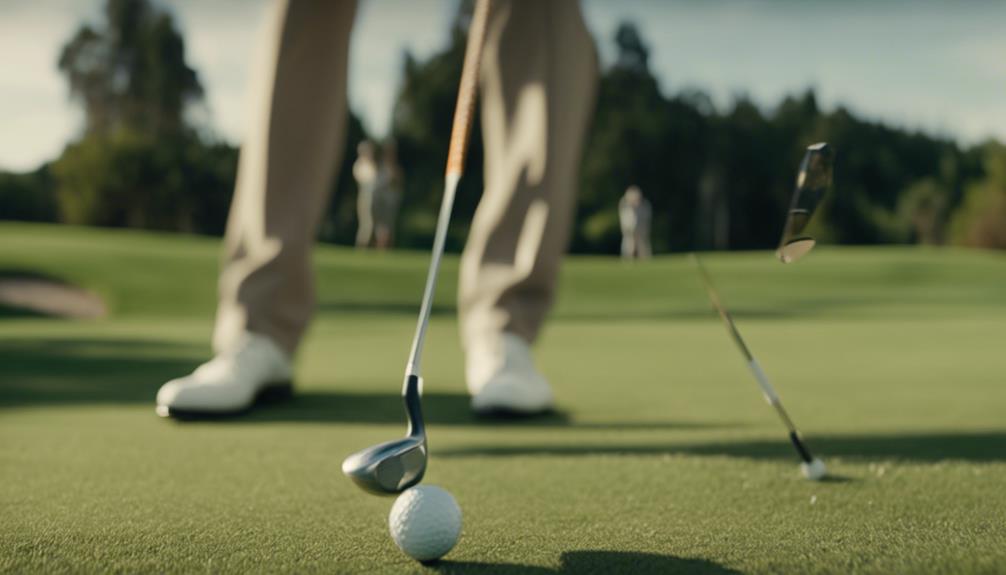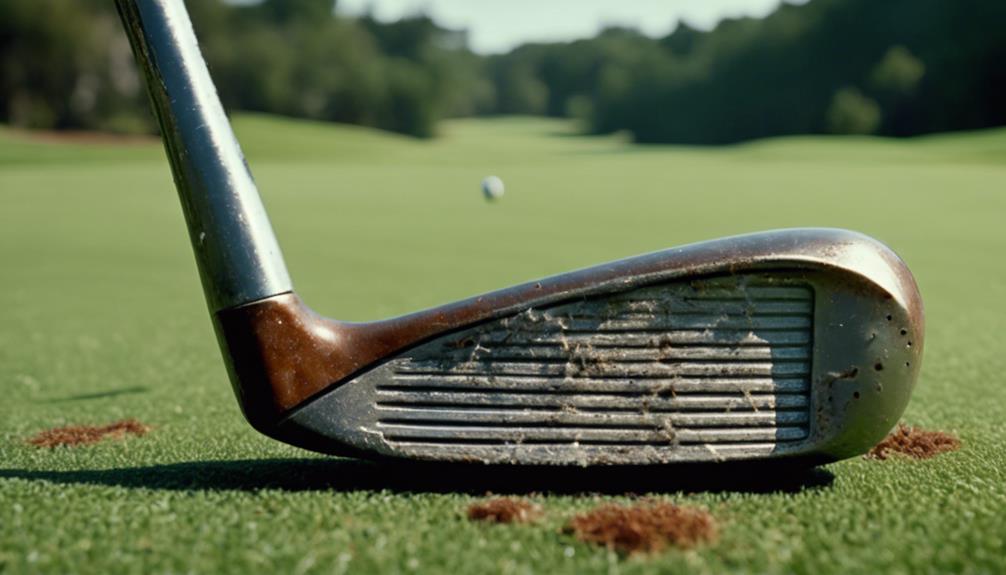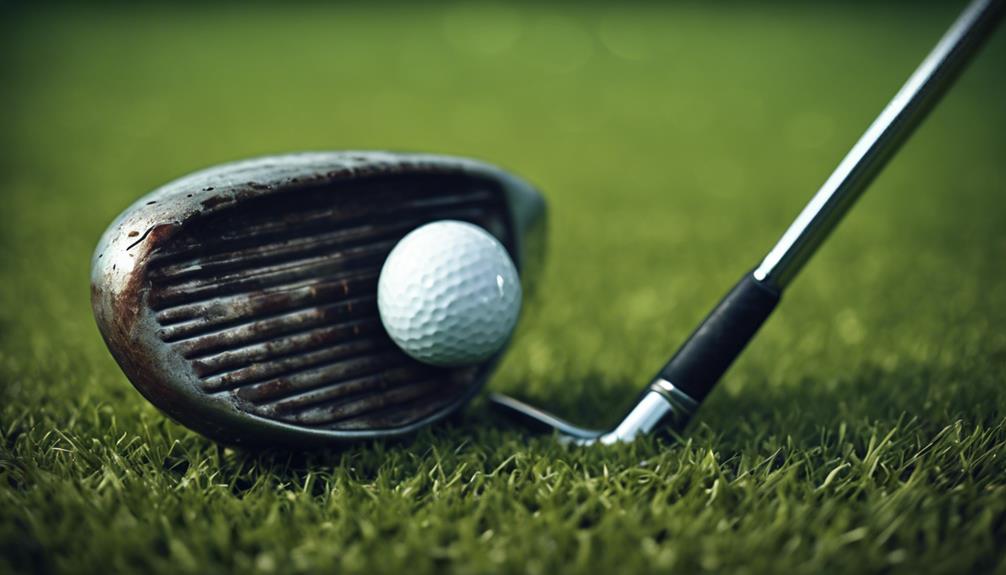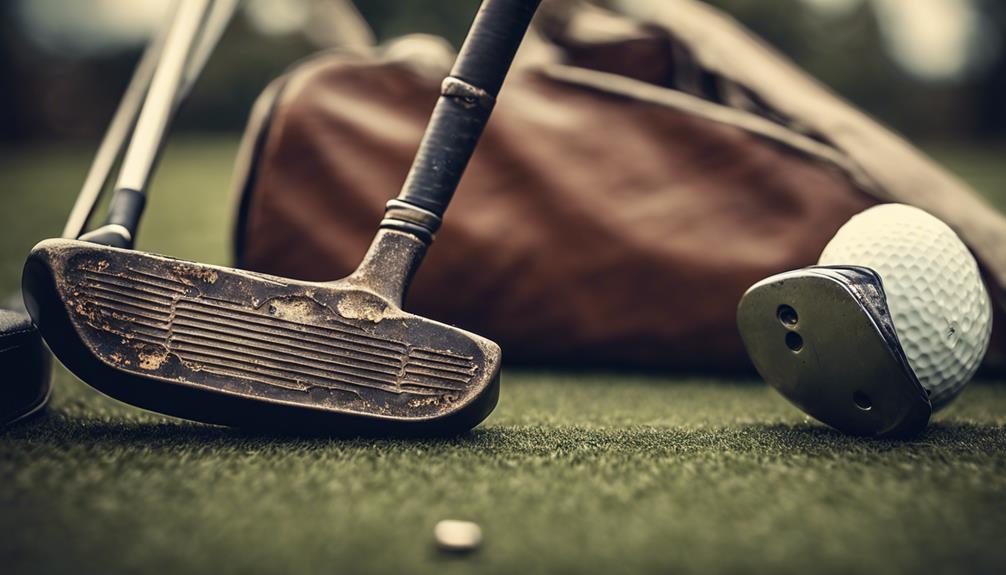- 7 Top Flite Golf Clubs XL for Improved Performance - September 28, 2024
- Top Flite Golf Clubs: Top 5 Reasons to Choose Them - September 28, 2024
- Top 3 Golf Club Fitters for a Perfect Swing - September 28, 2024
You're struggling to maintain distance and control, and your scores are suffering. Outdated technology in your driver, worn-out wedge grooves, and inconsistent iron performance are likely culprits. Visible signs of wear and tear, such as scuffs, rust, or cracks, are also affecting your game. It's time to ponder upgrading for better forgiveness, or taking steps to extend your clubs' lifespan. If you're noticing inconsistent performance, poor divot patterns, or a decline in distance, it may be time to reassess your gear. Take a closer look at your clubs – you might be surprised at what's hindering you from taking your game to the next level.
Key Takeaways
- Losing distance and control, or experiencing faltering control off the tee and on approach shots, may indicate a need for new golf clubs.
- Visible signs of wear and tear, such as worn-out wedge grooves, cracks, or rust on club heads, compromise performance and require replacement.
- Inconsistent performance and spin, including varying ball trajectory and distance, signal issues with golf clubs that may need upgrading.
- If your clubs show signs of aging, such as faded grips, scuffs, or scratches, it may be time to consider replacing them for better forgiveness and performance.
- A noticeable decline in performance, such as shorter drives or wayward shots, indicates a need to replace your driver or other golf clubs.
Losing Distance and Control
Fading distance and faltering control off the tee and on approach shots can be a telltale sign that your current golf clubs are no longer up to par. You're probably losing distance, and it's not just your swing. If you're struggling to hit the ball as far as you used to, it may be due to outdated technology in your driver.
Additionally, if you're finding it tough to control your approach shots, worn-out wedge grooves could be the culprit. Inconsistent distance control is another red flag, indicating that your irons' grooves may be worn out, affecting your overall performance.
Take a closer look at your clubs. Are you losing grip due to shiny, slippery, or worn grips? It's time to upgrade. Visual damage, such as scuffs or rust, can also impact your game. Don't let subpar equipment hold you back from achieving mastery.
Visible Signs of Wear and Tear
Many of your clubs are likely showing visible signs of wear and tear, from worn grooves on the club faces to cracks, dents, or rust on the club heads. These signs can greatly impact your game, and addressing them is crucial.
Take a closer look at your clubs; are the grooves on the club faces worn, affecting spin and distance control? Are there cracks, dents, or rust on the club heads, compromising performance and ball flight? Don't forget to inspect your grips; are they faded or peeling, causing slipping during swings and affecting control?
Missing badges or decals on clubs may indicate structural damage or aging, while scuffs or scratches on club shafts can compromise the integrity of the clubs.
If you've noticed any of these visible signs of wear and tear, it may be time to upgrade your clubs. Remember, worn-out clubs can impede your performance and progress. Take the time to assess your clubs' condition and make the necessary changes to enhance your game.
Inconsistent Performance and Spin

Inconsistent performance, marked by varying ball trajectory and distance, is a telltale sign that your golf clubs may be hindering your game. If you're experiencing abrupt halts on fairways or hovering irons, it's likely due to excessive rotation on your shots. This can negatively impact your distance and control, affecting your overall performance on the course.
Modern clubs focus on decreasing rotation and boosting launch height for improved distance and accuracy. Upgrading from older clubs with high rotation rates can greatly enhance your game and consistency.
Take a closer look at your rotation rate – if it's too high, it may be holding you back. New clubs can help you achieve a more uniform ball trajectory and distance, giving you more confidence and control on the course.
Don't let your clubs hold you back – if you're experiencing inconsistent performance and excessive rotation, it may be time to upgrade to clubs that will help you elevate your game. By reducing rotation and increasing launch height, you can achieve more uniform results and start playing the game you know you're capable of.
Upgrading for Better Forgiveness
When you're struggling with inconsistent performance, upgrading your golf clubs for better forgiveness can be a game-changer. By investing in clubs with advanced forgiveness technologies, you'll experience more consistent results, even on off-center strikes.
Now, let's explore how better forgiveness options, improved distance control, and enhanced spin performance can take your game to the next level.
Better Forgiveness Options
You'll notice a significant difference in your game with newer clubs that boast larger sweet spots and perimeter weighting, designed to reduce the penalty of off-center strikes. These advanced designs offer improved forgiveness options, allowing you to maintain distance and accuracy even on mishits.
By upgrading to modern clubs, you'll experience enhanced forgiveness across the face, resulting in more consistent shots.
As a golfer, you know that even slight mis-hits can throw off your entire game. But with modern club technology, you can minimize the impact of these errors. Newer clubs cater to golfers of varying skill levels and swing speeds, providing forgiveness options that suit your unique needs.
High-handicap players, in particular, can benefit from upgrading to clubs with improved forgiveness, as it can help reduce the effects of mis-hits and improve overall consistency.
Improved Distance Control
Upgrading to newer golf clubs can greatly enhance your distance control by minimizing the impact of mishits, allowing you to achieve more consistent results. With advanced technology, new clubs offer better forgiveness, which translates to improved distance control on off-center hits. You'll notice a significant reduction in the variation of your shot distances, resulting in increased consistency in your approach shots.
Better forgiveness in modern clubs means you'll experience fewer wayward shots, and when you do mishit, the distance control will be more predictable. This leads to more confidence in your game, as you'll be able to better anticipate the outcome of your shots.
Upgrading your clubs for better forgiveness can lead to more consistent distance and improved overall performance. By minimizing the impact of mishits, you'll be able to dial in your distances more accurately, giving you a competitive edge on the course. With improved distance control, you'll be able to attack pins with more precision, leading to better scores and more enjoyment on the course.
Enhanced Spin Performance
By minimizing the impact of mishits through improved forgiveness, you can now focus on optimizing your spin performance, which is critical for achieving better distance and control. Excessive spin can be a major performance killer, causing shots to float in the air and come to a quick stop on the fairway.
New Golf clubs, on the other hand, are designed to reduce spin and increase launch height, resulting in improved overall performance.
If you've been playing with older clubs, especially those from the mid-2010s or last decade, it's likely you're sacrificing distance and control due to high spin rates. Upgrading to newer clubs with low-spin technologies can greatly enhance your spin performance.
Extending Club Lifespan Tips

Proper care and maintenance can greatly prolong the lifespan of your golf clubs. By following a few simple tips, you can keep your clubs in top-notch condition and maintain they continue to perform at their best.
| Tip | Description | Benefit |
|---|---|---|
| Use Head Covers | Protect clubs from scratches and damage | Prevents unnecessary wear and tear |
| Store Clubs Properly | Keep clubs in a cool, dry place | Preserves club condition and prevents damage |
| Clean Clubs Regularly | Remove dirt and debris from clubs | Extends club lifespan and enhances performance |
| Avoid Exposure | Keep clubs away from harsh chemicals and abrasive materials | Prevents premature deterioration |
| Perform Regular Inspections | Check clubs for damage and address maintenance promptly | Prolongs club lifespan and ensures peak performance |
Signs You Need New Irons
As you examine your iron set, worn-out grooves, visible damage, or a decline in performance may signal that it's time to assess replacing them with new irons that can help you regain control and consistency on the course.
Worn grooves can lead to inconsistent distance control on your shots, while visibly damaged irons, such as scuffs or rust, can affect your performance. If you're experiencing a lack of control on approach shots, it may be time for a new set of irons. Old iron technology can result in a decline in overall performance and accuracy, making it harder to reach your goals.
Upgrading your irons can help improve your ball-striking consistency and overall game. If you've had a club re-gripped recently, but still notice a decline in performance, it may be time to evaluate a new set.
Don't hesitate to invest in a new set of irons if you need a new level of control and consistency. With the right irons, you can take your game to the next level.
When to Replace Your Driver

You've likely reached the point where your driver needs replacement if you've noticed a decline in performance, such as shorter drives or wayward shots, over the past 3-5 years or around 150 rounds of play. This decline can be attributed to the natural wear and tear on your clubface, which affects your launch angle, spin rate, and overall performance off the tee.
Signs you need a new driver include decreased distance and loss of accuracy, as well as visible wear on the clubface. Upgrading to a new driver can notably improve your game, thanks to advanced club technology like adjustable weights and customizable settings.
Consult with a PGA Professional or club fitter to determine the best driver replacement based on your swing characteristics and needs. They can help you find a new driver that optimizes your performance and takes your game to the next level.
Don't wait any longer to upgrade – consider driver replacement today and start driving like a pro!
Poor Divot Patterns and Solutions
Large divots behind the ball indicate that your irons or wedges are lacking sufficient bounce, resulting in poor ball control and consistency off the turf. This is a clear sign that you need to reassess your equipment.
Take a closer look at your divot patterns – are you consistently digging deep into the ground or taking large chunks of turf? This can be a sign that your irons or wedges aren't properly fitted to your swing type.
If you're a digger, you may benefit from wide-soled irons with high bounce, which can help reduce digging and improve ball control. On the other hand, if you have a more shallow swing, you may need irons with less bounce. Understanding your divot pattern can help determine the right clubs to enhance your game and prevent unnecessary damage.
Outdated Technology Holding You Back

With every passing year, golf club technology advances, leaving outdated models in the dust, and it's likely that your old clubs are hindering your performance. You may not even realize the impact of outdated technology on your game. Take a closer look at your current clubs and ask yourself: are they holding you back?
| Older Club Technology | Newer Club Technology | Benefits of Upgrading |
|---|---|---|
| Worn-out grooves on irons | Improved groove design for consistent distance control | Better accuracy and control |
| Less forgiving club designs | More forgiving club designs with enhanced playability | Wider sweet spot for more consistent shots |
| Limited adjustability | Adjustable features for optimized performance | Customized fit for your swing |
If you're still using older golf club technology, you may be sacrificing distance and accuracy off the tee. Outdated club designs can lack the forgiveness and playability of modern clubs, making it harder to improve your game. By upgrading to clubs with improved materials and technology, you can optimize your performance and take your game to the next level.
Time to Upgrade Your Gear
As you continually push yourself to improve your game, it's important to recognize the signs that indicate it's time to upgrade your gear. You've been playing with the same clubs for years, and it's likely they're no longer performing as well as they used to. If you're noticing a decline in your performance, it may be time to upgrade.
Here are some obvious signs you need to upgrade your gear:
- Visible wear and tear: Cracks, worn-out grooves, and other visible signs of damage are a clear indication that it's time to replace your clubs.
- Distance gaps: If you're noticing significant distance gaps between your clubs, it may be time to upgrade to a new set with more consistent distances.
- Declining performance: If your scores are suffering due to a lack of distance, accuracy, or control, it may be time to upgrade to clubs that can help you improve your game.
- Years of use: If you've been using your clubs every week for years, there's a good chance they're no longer performing as well as they used to.
Upgrading your gear can help you take your game to the next level. Don't be afraid to invest in new clubs – it may be just what you need to improve your performance and reach your golfing goals.
Frequently Asked Questions
How Do I Know When I Need New Golf Clubs?
You'll know it's time for new golf clubs when you notice club head damage, grip wear, or shaft rusting, which can cause decreased performance, or if you're struggling with incorrect club fit, hindering your game.
How Do I Know if My Golf Clubs Are Still Good?
As you navigate the golf course, imagine your clubs as a finely-tuned orchestra, where each instrument harmonizes in perfect sync. You know your clubs are still good if you've maintained them well, replaced grips regularly, inspected for shaft damage, and guaranteed a proper club fitting, with performance indicators like consistent distance and accuracy still singing in tune.
How Do You Tell if Your Irons Are Worn Out?
You inspect your irons for signs of wear by checking for rusty shafts, worn grooves, dented heads, loose grips, and bent clubs, as these indicators can greatly impact your game's performance and consistency.
When Should You Upgrade Golf Clubs?
You upgrade golf clubs when you notice performance decline, consistency issues, or physical damage, or when you want to leverage technology advancements or cater to personal preferences, ultimately refining your game and style.
Conclusion
As you stand on the course, your trusty clubs by your side, it's time to face the music – they're no longer the faithful companions they once were.
The thrill of the game has given way to frustration and disappointment.
It's like trying to drive a rusty old car – it's time to trade it in for a sleek new ride.
Don't let outdated technology hold you back any longer.
Upgrade your gear and watch your game soar to new heights, leaving your competition in the dust.




